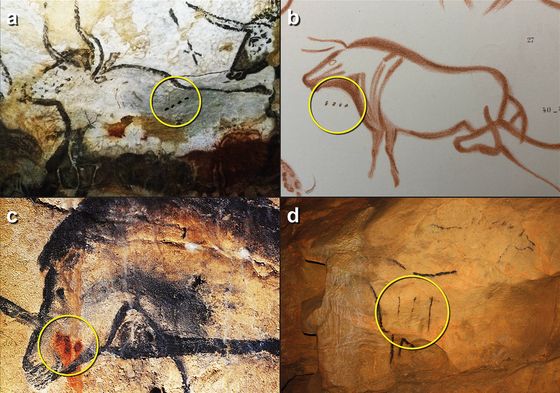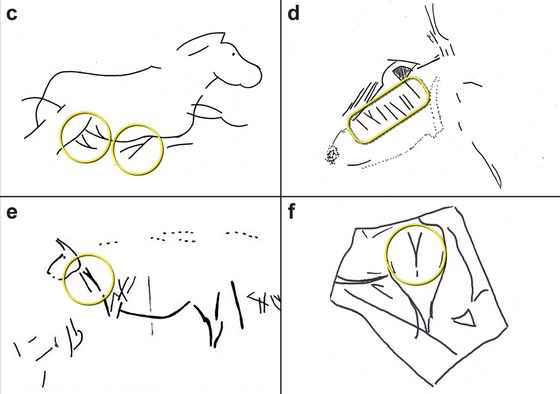An amateur scholar discovered that the mysterious figure drawn in the ice age cave painting about 20,000 years ago represented a kind of 'calendar'

In cave paintings drawn in Europe around 20,000 years ago in the
An Upper Palaeolithic Proto-writing System and Phenological Calendar | Cambridge Archaeological Journal | Cambridge Core
https://doi.org/10.1017/S0959774322000415
20,000-year-old cave painting 'dots' are the earliest written language, study claims.
https://www.livescience.com/ice-age-cave-art-proto-writing-claim
Amateur archaeologist uncovers ice age 'writing' system | Archaeology |
https://www.theguardian.com/science/2023/jan/05/amateur-archaeologist-uncovers-ice-age-writing-system
Humans living in Europe when the Earth was still in the Ice Age painted cave paintings of animals such as reindeer, fish, and the aurochs , the ancestor of the cow. In hundreds of cave paintings drawn in Europe around 20,000 years ago, figures such as “|” (line), “・” (dot), and “Y” are frequently drawn near animals. Although archaeologists thought that ``this figure has some meaning,'' it was not clear what it meant.
British amateur archaeologist Bennett Bacon investigated past research papers and images of cave paintings held in the British Library to analyze recurring patterns. Below are some examples of lines and dots found in actual cave paintings.

Also, below is an example of the 'Y' mark drawn by Mr. Bacon.

After analysis, Bacon suspects that the 'Y' mark next to the animal represents 'childbirth,' while the other lines and dots represent months according to the
For human beings who were hunter-gatherers at the time, the birth time of animals was important information useful for hunting, and ``Y'' may mean ``childbirth'' by dividing one line into two. The paper states that there is In total, more than 800 cave paintings and other iconography have no more than 13 lines or dots, which corresponds to the number of lunar months, which are about 29.5 days long.
When the research team analyzed the relationship between the breeding season of each animal and the number of lines and dots based on the lunar calendar starting in spring, it was confirmed that the number of lines and dots was strongly correlated with the breeding season of the animal. it was done. In addition, it was also suggested that the month marked with 'Y' in the series of lines and dots corresponds to the 'birth' of each animal.
Since the figure deciphered this time is a record of numerical information rather than voice or language, it cannot be considered on the same level as the writing system such as ancient Egyptian hieroglyphs and Mesopotamian civilization cuneiform , but the research team has a series of I think that figures are a kind of ' proto-writing ' that strongly evokes the characteristics of the writing system.
``Our research shows that Ice Age hunter-gatherers were the first to use systematic calendars and marks within those calendars to record information about major ecological events,'' Pettit said. 'As we explored the world of our ancient ancestors more deeply, we found that they were much closer to us than we had previously thought,' said Bacon.

by Walwyn
However, some researchers are cautious about the results of Mr. Bacon et al. Melanie Chan , a paleoanthropologist at Portland State University , said in an email to Live Science that the Upper Paleolithic people had the cognitive ability to write and keep track of time. Although he agrees, he points out that the hypotheses put forward in the paper are not well supported and that other possible interpretations are not addressed.
'Studying non-graphical signatures in more detail is welcome, but it seems to me that there are a number of unproven assumptions in this study,' said April Nowell , an archaeologist at the University of Victoria . ' commented. Mr. Nowell casts doubt on the premise that the 'Y' sign means childbirth, and Mr. Chan cites the possibility that the 'Y' indicates an anatomical feature of the animal rather than childbirth. I'm here.
Nowell, who once created a database of patterns found in Paleolithic cave paintings, agrees that ``the lines and dots represent numbers,'' but that they are often found in cave paintings. He pointed out that there are 32 patterns including lines, dots, and Y. Even if the results of this research were correct, he said that there are still many unknown points about the Paleolithic figures.
Related Posts:
in Science, Posted by log1h_ik







